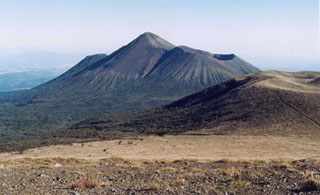Report on Kirishimayama (Japan) — April 1992
Bulletin of the Global Volcanism Network, vol. 17, no. 4 (April 1992)
Managing Editor: Lindsay McClelland.
Kirishimayama (Japan) Steam emission; minor ashfall
Please cite this report as:
Global Volcanism Program, 1992. Report on Kirishimayama (Japan) (McClelland, L., ed.). Bulletin of the Global Volcanism Network, 17:4. Smithsonian Institution. https://doi.org/10.5479/si.GVP.BGVN199204-282090
Kirishimayama
Japan
31.934°N, 130.862°E; summit elev. 1700 m
All times are local (unless otherwise noted)
Steam emission continued steadily in April to 100-200 m height. A light dusting of ash was noted on leaves in the crater during a 6 April visit. The maximum measured fumarole temperature was 96°C. Seismicity was at low levels in April, but a weak tremor episode was recorded on the 11th. A monthly total of 23 small earthquakes was recorded, almost unchanged from March. Similar activity continued through early May.
Geological Summary. Kirishimayama is a large group of more than 20 Quaternary volcanoes located north of Kagoshima Bay. The late-Pleistocene to Holocene dominantly andesitic group consists of stratovolcanoes, pyroclastic cones, maars, and underlying shield volcanoes located over an area of 20 x 30 km. The larger stratovolcanoes are scattered throughout the field, with the centrally located Karakunidake being the highest. Onamiike and Miike, the two largest maars, are located SW of Karakunidake and at its far eastern end, respectively. Holocene eruptions have been concentrated along an E-W line of vents from Miike to Ohachi, and at Shinmoedake to the NE. Frequent small-to-moderate explosive eruptions have been recorded since the 8th century.
Information Contacts: JMA.

